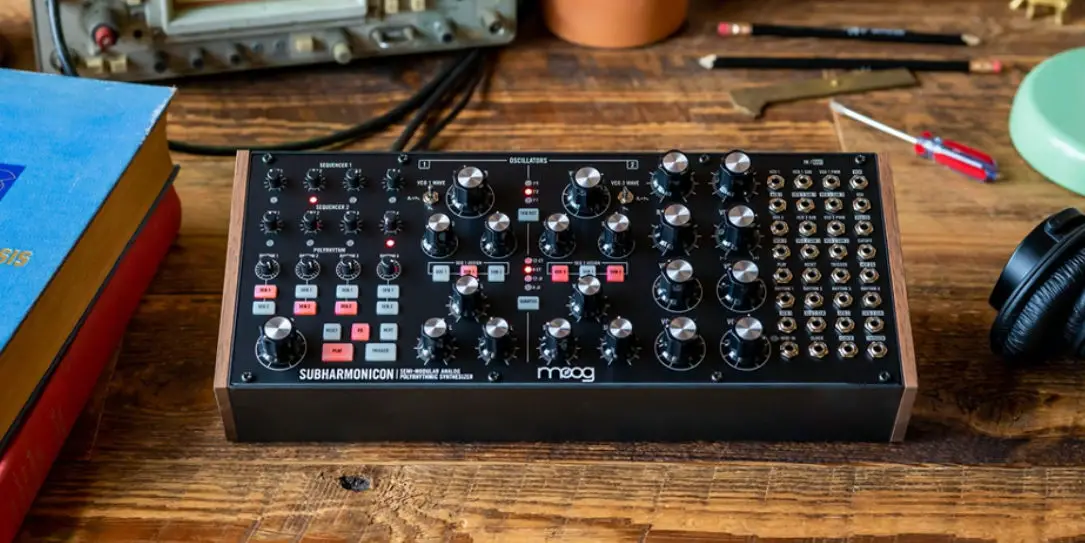The Moog Subharmonicon is a new semi-modular analog polyrhythmic synthesizer and is now available worldwide. Moog was founded back in 1953 by Robert Moog and produces electronic instruments that have been used by nearly everyone you’ve heard.
The Moog Subharmonicon is an analog labyrinth of subharmonically derived synthesis and polyrhythmic patterns which the company says is “equally suited for losing oneself and simultaneously finding oneself through sound.” Trippy descriptors for sure. This new semi-modular analog synthesizer is designed for the exploration of sequences that unfold and evolve over time, spiraling through six-tone subharmonic chords and organic polyrhythms.
I personally have never gotten into keyboards or synth instruments and have mostly stuck to guitars and stringed instruments. But devices like the Moog Subharmonicon have always intrigued me. Here’s a bit of what Moog has to say about the Moog Subharmonicon:

The newest addition to Moog’s family of semi-modular analog synthesizers (Matriarch, Grandmother, Mother-32, and DFAM), Subharmonicon is capable of complex sounds and patterns, yet is incredibly simple to use. With two VCOs, four Subharmonic Oscillators, two 4-Step Sequencers, and four Rhythm Generators, this new musical machine creates a rich harmonic kaleidoscope that divides into itself until everything that is up, becomes down. Although no patching is required to start creating, Subharmonicon can be patched into itself, expanding its onboard capabilities, or interfaced with Mother-32, DFAM, and other external Eurorack-compatible gear for endless possibilities.
To design Moog Subharmonicon, Moog drew inspiration from radical theories on music composition that arose in experimental circles during the 1930s and 1940s. Moog Subharmonicon is inspired by Joseph Schillinger’s mathematical systems for musical composition and is influenced by two analog innovations from the 1930s and 1940s: the Mixtur-Trautonium, which employed a series of subharmonic oscillators to generate electronic undertones, and the Rhythmicon (developed by Leon Theremin, the inventor of the Theremin), an instrument capable of sounding multiple harmonically related polyrhythm generators simultaneously. Learn more about these historical instruments and how the past continues to inform the future of sound here.
“A long time ago, when I was in college and first met Bob [Moog], the Rhythmicon came up a couple of times,” recalls Steve Dunnington, Senior Hardware Lead at Moog Music. “One of his other students was into Schillinger…and I’ve always been fascinated by patterns that repeat differently each time…and that’s a thing you can explore [with Moog Subharmonicon]. This instrument was inspired by some of the ideas and musical concepts of Schillinger, such as the idea that by taking a set of pitches and superimposing them on a set of rhythms with a different length will generate rotating musical motives.” Under Dunnington’s direction, a small group of synth enthusiasts had the chance to discover Subharmonicon’s unique sounds and concepts back in 2018 when an early version of the instrument was first introduced as part of that year’s Moogfest Engineering Workshop. It’s been in high demand ever since, and the instrument is now shipping to authorized Moog dealers worldwide.
The Moog Subharmonicon is certainly an interesting piece of musical tech gear and something I’d be willing to explore but not sure I’d master. Find out more about the Moog Subharmonicon over on the company’s website.
What do you think of the Moog Subharmonicon? Let us know in the comments below or on Twitter, or Facebook. You can also comment on our MeWe page by joining the MeWe social network.
Last Updated on February 3, 2021.









